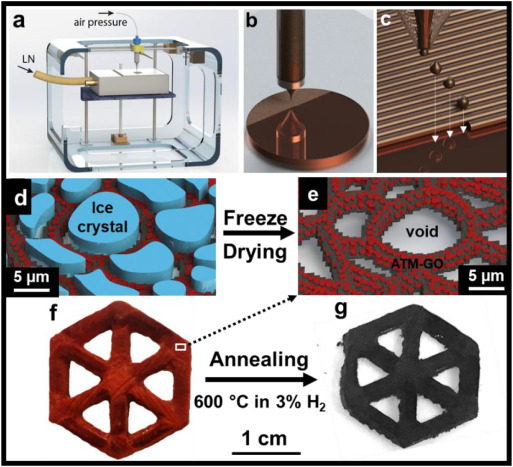Kansas State University: 3D Freeze Printing Used to Create Batteries
3D design and printing can be integrated into nearly any industry today, but researchers around the world persist in using it to harness energy, and especially for storage—as in the ubiquitous battery. Researchers from Kansas State University examined previous studies and then delved into much more intricate research with an inkjet 3D printer using freeze casting to control materials for storing energy.
Numerous forays have been made into the study of 3D printing with electronics and the creation of batteries, but as the authors discuss in their recently published paper, ‘3D printing of hybrid MoS2-graphene aerogels as highly porous electrode materials for sodium ion battery anodes,’ previous work has been centered around more common materials like lithium iron phosphate (LFP) and lithium titanium oxide (LTO), along with 3D printing of disk electrodes and nanocrystal inks.
For this study, the researcher used a new technique for preparing highly porous MoS2/graphene hybrid aerogels as the anode for sodium ion batteries (SIBs).
“Such interconnected porous structures are critical in mitigating the stress induced by the larger volume changes during charge-discharge cycles than that in the previous LIB studies due to the combination of higher specific capacity (over 300 mAh/g) and larger ion size (0.102 nm for Na+ vs 0.076 nm for Li),” stated the researchers.

Schematics of the 3D “drop-on-demand” ink jet printing setup (a) and the printing process of the ATM-GO droplets in a raster fashion (b–c). Ice template formation (d) during printing and the resulting ATM-GO aerogel after freeze drying (e). An example macrostructure of the 3D printed ATM-GO aerogel after free-drying (f) and the resulting MoS2-rGO aerogel after reductive thermal annealing (g). (For interpretation of the references to color in this figure, the reader is referred to the web version of this article.)
Both graphene and molybdenum disulfide (MoS2) are known to have exceptional qualities, as 2D layered materials that have been well-studied already. There are challenges, as MoS2 is known to deteriorate rapidly, and electrical conductivity is low. Graphene compensates for any disadvantages there, however, with superior conductivity, flexibility, and chemical resistance.
Using a cold substrate plate, ink droplets are frozen during 3D printing, beginning the process for creating hybrid aerogel-based 3D architectures for batteries. Precursor ink was created as nanoflakes were placed in deionized water an then pressed onto the cold plate set at −30 °C. The droplets quickly froze into ice crystals and then formed a matrix, after which they were put into a freezer and later transferred to form the required aerogel and go through consequent refinements.
“The printed architectures were clearly retained after going through all these processes,” stated the researchers. “To the best of our knowledge, it is the first time to achieve 3D printing of MoS2-rGO hybrid aerogels.”
The authors of the study also note that the MoS2-rGO aerogel is much different from those created through more common methods in 3D printing and freeze-drying materials. They postulated that the open 3D Ni foam framework must have transformed the temperature, along with preventing large ice crystals from forming.

Low a) and high b) magnification SEM images of MoS2-rGO printed on Ni foam. EDS layered elemental mapping of c) all elements, d) sulfur (red), e) molybdenum (purple), f) carbon (green) and g) oxygen (blue). (For interpretation of the references to color in this figure legend, the reader is referred to the web version of this article.)
Overall, the aerogels were successfully 3D printed with the freeze-printing technique, with the graphene network increasing conductivity and strength, while large pores make rapid ion transport possible.
“This study demonstrates the potential to use 3D printing technology to fabricate the macroporous electrode materials that can sustain high-capacity intercalation of large Na+ ions, which opens a new direction of 3D printing for energy storage applications,” concluded the researchers.
Energy is one of the most critical commodities on Earth, allowing us to perform many daily activities comfortably, and with many battery-driven machines and objects. Because the benefits of 3D printing so often include greater affordability, speed in production, and the ability to innovate like never before, researchers have looked into how it could improve battery manufacturing, from wearables to sensors to applications requiring materials like graphene. Find out more about hybrid MoS2-graphene aerogels in batteries here. What do you think of this news? Let us know your thoughts! Join the discussion of this and other 3D printing topics at 3DPrintBoard.com.
[Source / Images: ‘3D printing of hybrid MoS2-graphene aerogels as highly porous electrode materials for sodium ion battery anodes’]

